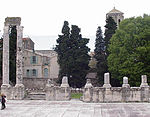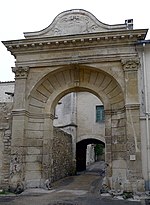Arles Amphitheatre

The Arles Amphitheatre (French: Arènes d'Arles) is a Roman amphitheatre in Arles, southern France. Two-tiered, it is probably the most prominent tourist attraction in the city which thrived in Ancient Rome. The towers jutting out from the top are medieval add-ons. Built in 90 AD, the amphitheatre held over 20,000 spectators of chariot races and bloody hand-to-hand battles. Nowadays, it draws smaller crowds for bullfighting during the Feria d'Arles, as well as plays and concerts in summer. In 1981, Arles Amphitheatre was listed as a UNESCO World Heritage Site, together with other Roman and medieval buildings of the city, as part of the Arles, Roman and Romanesque Monuments group.
Excerpt from the Wikipedia article Arles Amphitheatre (License: CC BY-SA 3.0, Authors, Images).Arles Amphitheatre
Rambla Doctor Claudio Williman,
Geographical coordinates (GPS) Address Nearby Places Show on map
Geographical coordinates (GPS)
| Latitude | Longitude |
|---|---|
| N 43.677777777778 ° | E 4.6311111111111 ° |
Address
Parada 2 Mansa
Rambla Doctor Claudio Williman
20100
Maldonado, Uruguay
Open on Google Maps






